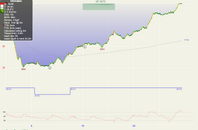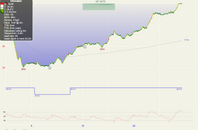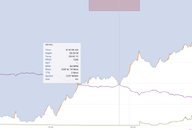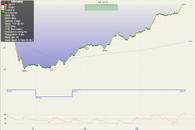Hey all, thank you so so much for all your input you guys are amazing and I think I do now understand the theory behind it, it's very interesting to know!
Regarding the deco dive I did - agree the numbers indicated seems very odd, here's some background to the dive:
Computer used: Garmin Descent MK1
Software used: Macdive
Algorithm used: Bühlmann ZHL16C 35/75 (Very sorry I misread previously, it should be 35/75 and it's one of the default GFs on Garmin)
Gas: standard single tank with air
- I got curious about tech / deco so I looked back at my previous dives and this was the only deco dive I've ever had so was trying to look into it and learn from there. I was very new (still am...) and could not recall the time the computer showed during the deco back then.
- Macdive indeed shows 17min. Deco started with 1min @ 3m; 5min later deco jumped to 17min; another 2 min later deco cleared with 31min NDL (note that "deco schedule" on Macdive still shows 1min @ 3m as the red box indicated). I have messaged Macdive and their response is that all related figures come from the computer itself.
- Have also imported the dive into Subsurface, essentially the same but subsurface doesn't have a dynamic time during the deco, please see the below screen cap.
Would it be possible that it's some other calculations other than the actual deco time?
By the way, is it usual to have quite a bit of NDL immediately after the deco is cleared?
Thanks again!
@KenGordon
I have compared threeof the GF you've listed. Kindly see below, Garmin NDL in brackets: (no descent times are included in Garmin's planner) Unsure why the very small change between the two on Garmin between 40/85 and 85/85 tho...
40/85:
NDL at 12m = 30.80 minutes inc descent 31.50 (122:48)
NDL at 18m = 11.20 minutes inc descent 12.20 (42:54)
NDL at 24m = 5.60 minutes inc descent 6.90 (20:05)
NDL at 30m = 3.20 minutes inc descent 4.80 (12:06)
NDL at 36m = 1.70 minutes inc descent 3.60 (8:10)
NDL at 42m = 0.60 minutes inc descent 2.80 (6:16)
85/85
NDL at 12m = 122.90 minutes inc descent 123.60 (122:54)
NDL at 18m = 42.20 minutes inc descent 43.20 (42:56)
NDL at 24m = 19.60 minutes inc descent 20.90 (20:05)
NDL at 30m = 11.30 minutes inc descent 12.90 (12:06)
NDL at 36m = 7.20 minutes inc descent 9.10 (8:10)
NDL at 42m = 5.20 minutes inc descent 7.40 (6:16)
NDL at 48m = 3.90 minutes inc descent 6.40 (5:07)
NDL at 54m = 3.00 minutes inc descent 5.80 (4:2)
NDL at 60m = 2.30 minutes inc descent 5.40 (3:46)
100/100:
NDL at 12m = 177.10 minutes inc descent 177.80 (177:51)
NDL at 18m = 58.50 minutes inc descent 59.50 (58:56)
NDL at 24m = 28.00 minutes inc descent 29.30 (28:26)
NDL at 30m = 15.60 minutes inc descent 17.20 (16:18)
NDL at 36m = 10.00 minutes inc descent 11.90 (10:57)
NDL at 42m = 6.90 minutes inc descent 9.10 (7:59)
NDL at 48m = 5.10 minutes inc descent 7.60 (6:22)
NDL at 54m = 3.90 minutes inc descent 6.70 (5:19)
NDL at 60m = 3.10 minutes inc descent 6.20 (4:34)








